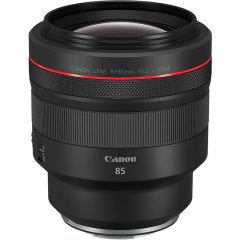The Canon RF 85mm f/1.2L USM has now been announced and available for pre-order for $2699.00 at B&H and Adorama.
Who said mirrorless lenses are smaller? This RF-mount lens is quite the beast: it weighs a solid 2.6 pounds, and is both larger and heavier than its EF 85mm f/1.2 II cousin. We’ll be interested in seeing if it can stand up optically to the hefty $2699 price tag.
- RF 85mm f/1.2L USM for $2699.00 at B&H, Adorama


The DSLR version already felt unbalanced to me on the 5DMkIV, and I eventually sold it. This monster will feel even more unwieldy on the lighter EOS-R, I’m afraid. Sad it has no image stabilization.
IS on a lens like this would only rob it of image sharpness. Besides, I would feel pretty confident the shutter speeds anyone will be using on this lens will be more than adequate to avoid handshake.
Huh, it’s about 100 USD cheaper than I guessed it would be. What a bargain, LOL. I’m sure it will be every bit as incredible as the RF 50mm F1.2.
“Is on a lens like this would only rob it of image sharpness.” Someone needs to explain this phenomenon… I personally switched from non stabilized body and lenses to one that has them, and all my pictures are sharper than ever…way more keepers than before. Stop spreading BS!
Actually, Kevin is correct: IS can rob an image of sharpness. Now if you are hand holding with longer shutter speeds, then IS can definitely help.
But there is a cost to IS; always has been; no such thing as a free lunch.
From B&H: it is well worth mentioning that, for the sharpest results when photographing still subjects, nothing beats a camera mounted on a sturdy tripod with the image stabilization turned off. This is because image stabilization, by its very nature, using motion along one axis to counter motion in the opposite axis, often creates varying degrees of image degradation of its own, whereas a camera firmly coupled to a stable tripod and tripped with a cable or remote release with the mirror locked in the up position will, in almost every instance, take a sharper picture.
–end of quote–
We are always used to thinking of any extra feature as something of value without any drawbacks, but in reality even something that can be very useful…IS…may have a real world cost.
The whole point of IS is for hand held. If you mount it on a tripod, there’s is no need for IS. Most portrait photographers, including myself, use 85mm handheld 99% of the time, and IS or ibis does have an advantage over non stabilized lenses; speaking from experience instead of reading some quote that may be published awhile back when IS technology was first introduced.
The question is, have you ever used and compared IS/ibis system yourself? If the answer is no, you really should try it before making comments here.
Canon Japan has a couple of sample images of this new lens and the detail is insane. Looks like it will be a winner diminishing other L lenses.
Well, for one, when turning off stabilization on a minimal depth of field set short telephoto lens, you assist the AF to have a better chance to nail the focus. The Tamron SP 85 is a great example of this (And an amazing lens)
Funny you have to turn off IS in order to nail focus. This is one reason I always stick with OEM. I own both the 35mm f/2 IS and 70-200mm f/2.8 L IS II. My IS is always on 100% of the time. I’m able to get sharp pix at 1/4 of a sec with my 35mm and 1/8 of a sec at 200mm. IS is a blessing in the world of photography, they gave you to option to turn off/on as your desire. Try shooting at 200mm at 1/8 handheld and you’ll see what I mean.